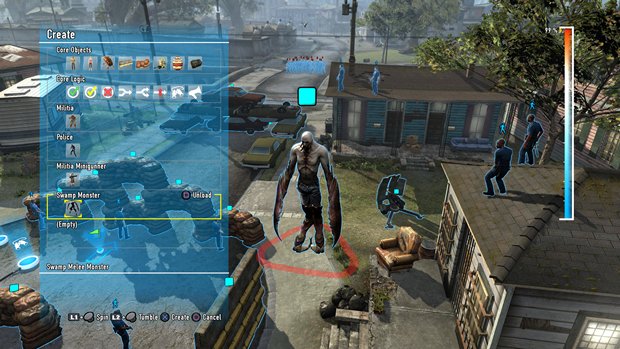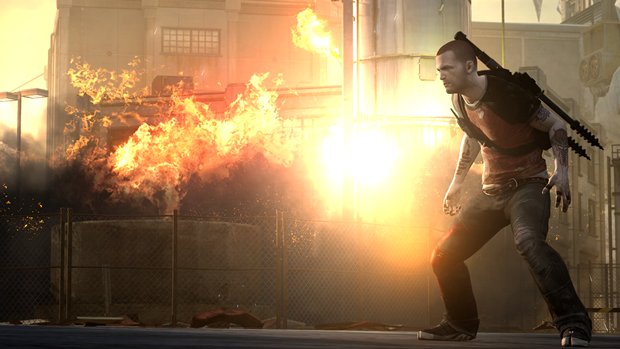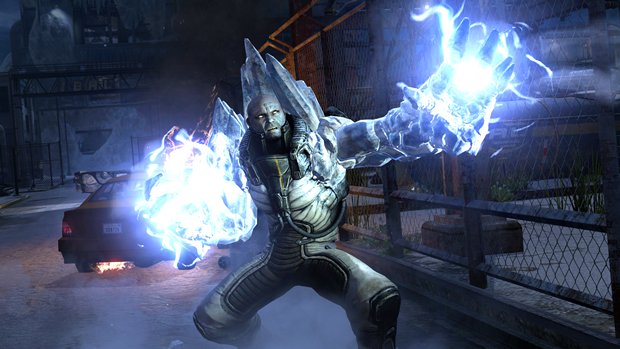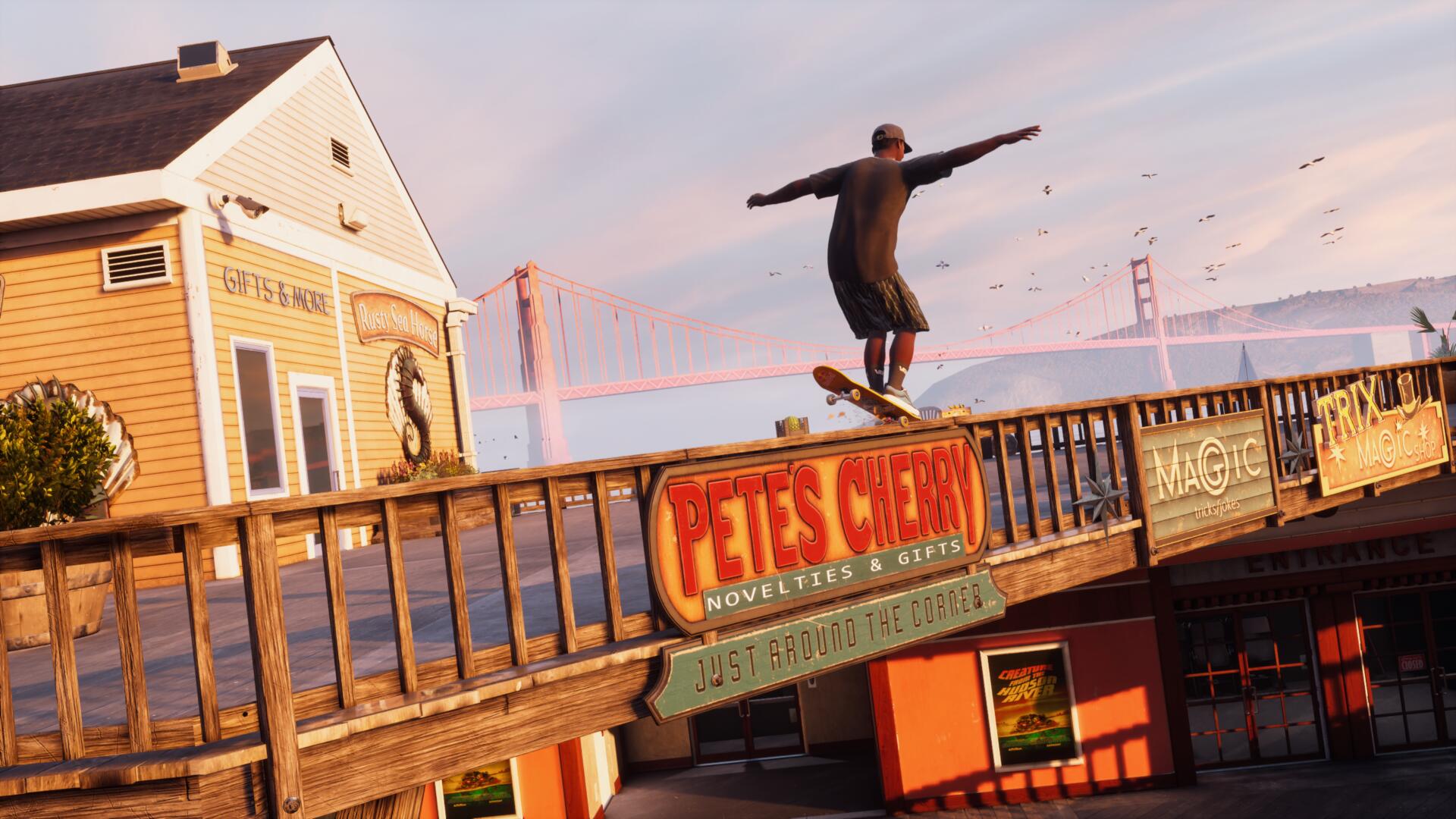InFamous 2 – hands-on with giant monsters and user-generated missions
Latest showing reveals new powers, new enemies and the inner workings of the mission creator
User-created missions, as you may already have heard, will populate into the single-player world as green mission icons, which can either be filtered to suit the player’s interest or turned off entirely. The first one we saw, Sheriff of New Marais, kicked things off with a simple cutscene (complete with text dialogue) that had electrically charged hero Cole MacGrath in a standoff with a group of gloating Militia thugs. Suddenly, all of them were run over by a pickup driven by Cole’s buddy Zeke, who immediately joined forces with Cole. We then blasted our way down the street as Militia goons took potshots from balconies, until we reached their leader: a hulking, chaingun-toting heavy flanked by goons with shields.

The second mission, titled “inVADERS,” was an impressive re-creation of Space Invaders, with Cole as the tank and a perfectly spaced, gradually quickening armada of bugs overhead. Blasting them actually gave us a chance to try out another Cole power: rapid-fire lightning bolts, replacing the usual pistol-style blasts with something more akin to machinegun fire.
Meanwhile, the third mission, “Zeke’s Story,” was a little more narrative-heavy than the other two, seeing as it revolved around Zeke telling an exaggerated story about Cole to a couple of women – which, as Cole, we then had to play through. Blasting through Zeke’s tall tale was actually easier than we thought it would be, considering the stuff that kept happening – one highlight was around a dozen chaingun heavies suddenly materializing out of thin air to surround Cole – and it was made slightly more interesting by the addition of another power, a lightning bolt that split into three and then seemed to home in on enemies.
So that’s all fine and good. Almost more interesting than the missions themselves, though, was seeing how they looked in the game’s content creator – which is to say like a staggering amount of once-hidden switches and logic circuits placed carefully throughout the world. The content creator is easy to slip into through the pause menu, and once you do, you’re given the option to create a mission from a template – of which there are currently 20 (with more likely to be added after release), which run the gamut from defend-the-cops and search-and-destroy missions to races where you’ll need to zip through rings as quickly as possible. Alternately, you can start from scratch. Either way, the perspective then shifts to a cursor that can move to any point in the game world and use to stamp down objects.
In our case, we chose a “defend” template, which plopped a couple of cops, barricades and a handful of angry Militia goons into the world. These were accompanied by a series of deceptively simple logic circuits that governed the characters’ behavior, as well as set parameters for victory or failure (i.e. if the cops die, the mission is failed).

Above: Also, if you want this monster to be friends with the cops, that's cool too
Our first impulse was to subvert and reverse the mission’s goals, making it so that we had to defend the poor Militia goons against the rampaging cops. This was not only easy, but took just a few minutes to do. For starters, it turns out that every object you rubber-stamp into the world is part of a “group.” These are created and designated by you beforehand, and they’re especially useful if you want a specific group of characters or objects to do a specific thing – like, say, dance in place, or attack a group of cops.
Weekly digests, tales from the communities you love, and more
The behavior of groups is regulated by “monitors,” LittleBigPlanet 2-style logic circuits that create"when (blank) happens, then (blank)"conditions based on whatever’s connected to them. To set terms for victory, for example, you’d set a few simple criteria within a monitor – say, the destruction or defeat of a designated group of objects or characters – and then connect it to a victory-condition switch. (Actually connecting these switches to each other should be instantly familiar if you’ve played LittleBigPlanet; after picking “connect” from a radial menu, you’ll be given a wire lead, which you can then plug into another circuit.)

In this case, there was a victory-condition monitor that stated that if the “enemies” group was destroyed, then the mission would be a success. So we immediately changed that “enemies” to “cops.” With step one complete, we then found the monitor that told the “cops” group what to target – in this case, “enemies” – and changed it so they’d target Cole instead. After that, we had to change the loss condition from all the cops getting killed to all the enemies getting killed, and then set the enemies’ behavior to “neutral” so that they wouldn’t attack Cole. Satisfied, we quickly started up the mission and dispatched the cops while the Militia stood around and listlessly watched.
There’s a lot more to the monitors than setting victory/defeat conditions and behaviors, though. It’s possible to cordon off a specific area and forbid Cole to enter or exit it on pain of mission failure, or to make, say, a group of enemies move much faster after a certain number of them are killed. It’s also possible to use splitters or combiners to create more complex circuits, awarding multiple results for accomplishing one action, or to make a single result reachable by several different actions.

In short, the system appears to be simple and ridiculously versatile. The things players create don’t even have to be conventional missions; it’s possible, for example, to suspend enemies on platforms in midair and create Angry Birds-like minigames where Cole has to knock them down with thrown objects. (After we asked nicely, the guy giving us the demo showed us how to make a simple version of this in about three minutes.)
Like with LittleBigPlanet, though, what you get out of this depends on what you’re willing to put in – or at least, what other people are willing to put in. With the semi-public UGC beta already in full swing as of this writing, it’ll be interesting to see what people come up with ahead of InFamous 2’s June 7 release
April 12, 2011



